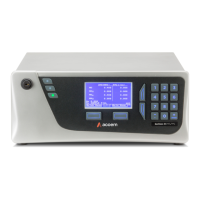3.4.19 Calculation Factors Menu
Main Menu Service Menu Calculation Factors Menu
The calculation factors provide the values used to calculate different aspects of measurement and
calibration.
Entering a value here will multiply the displayed and recorded
measurements by the dilution amount. For example, if the instrument
is measuring a source where the average concentration is above the
upper limit of the measurement range, a dilution probe with a fixed
ratio dilution ratio can be used to reduce the level measured by the
instrument, so for a 4:1 dilution ratio, enter a value of 4.
Enter the ratio here so the analyser can display the correct value on the
instrument.
The default value is 1.00 (this indicates no dilution is applied).
A multiplication factor used to adjust the concentration measurement
to the appropriate level (set at calibration).
This field displays the offset created from a NO zero calibration. This is
the concentration measured from zero air and is subtracted from all
readings.
This field displays the offset created from a NO
2
zero calibration. This is
the concentration measured from zero air and is subtracted from all
readings.
This field displays the offset created from a NH
3
zero calibration. This is
the concentration measured from zero air and is subtracted from all
readings.
The correction factor calculated from the background cycle (used to
eliminate background interferences).
Displays the correction factor applied to the concentration
measurement. This correction is for changes in pressure, temperature
and flows since the last calibration.
Displays the correction factor applied to the concentration
measurement. This correction is for changes in pressure, temperature
and flows since the last calibration.
Displays the correction factor applied to the concentration
measurement. This correction is for changes in pressure, temperature
and flows since the last calibration.
The overall efficiency of the conversion of NO
2
to NO, in the first
internal NO
2
to NO converter.
The overall efficiency of the conversion of NH
3
to NO, in the External
converter, combined with the efficiency of the second internal NO
2
to
NO converter.
The standard deviation of the concentration. The calculation is as
follows:
Take a concentration value once every two minutes.
Store 25 of these samples in a first in, last out buffer.
Every two minutes, calculate the standard deviation of the current

